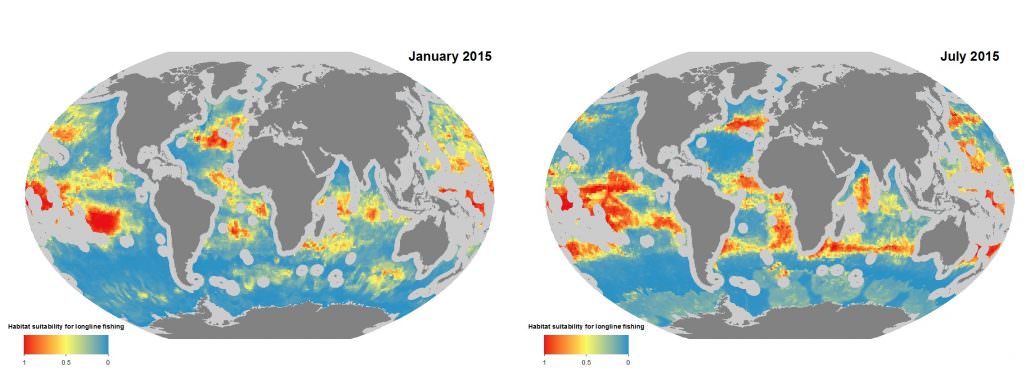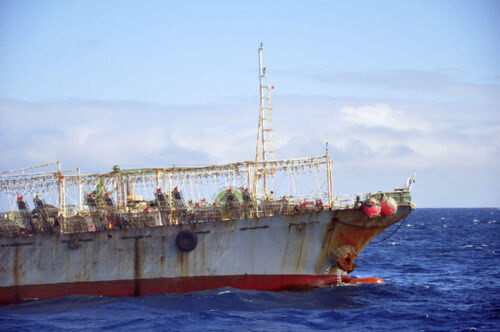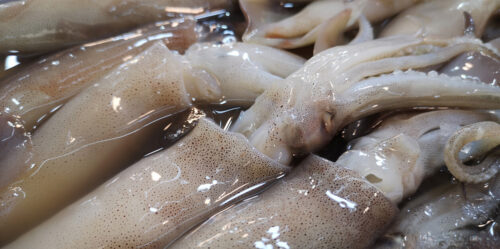
As the extent and diversity of ocean industries continues to grow, the international community faces the challenging task of accommodating multiple ocean uses while minimizing negative ecological impacts across sectoral industries. Oceanic fisheries have grown exponentially since the aftermath of the Second World War, however, governance, management and monitoring frameworks have not kept up. Recent research from Global Fishing Watch revealed that the footprint of fisheries covers most of the global ocean, and that pelagic longliners represent the most widespread form of fishing. Following up on this discovery, my team at Duke University led a study in conjunction with Global Fishing Watch, the University of British Columbia and Dalhousie University to explore the predictability of longline fishing effort in the high seas, which cover 45% of our planet.
Our study focused on fleets from Japan, South Korea, Chinese Taipei, China and Spain, which account for most of the longline fishing on the high seas. We linked fishing effort to 14 biophysical and physiographic ocean variables, such as sea surface temperature and distance to seamounts, to predict the distribution of longline fishing in the high seas. Fishermen typically use longline gear to catch swordfish, tuna and other commercially valuable fish that live in the upper depths of the sea, but their bait also attracts non-targeted marine species such as sharks and seabirds, which get snagged on the hooks or entangled in the lines. Our new predictive models, along with data on the distribution of target and non-target species, can estimate where the fleets are likely to interact with economically valuable species as well as endangered species.

Interestingly, it appears that many areas suitable for longline fishing are not actively fished by pelagic longliners. Previous studies suggest that decades of fishing pressure may result in range changes for many oceanic species. Therefore while our model may suggest that an area has favorable conditions for longline fishing, a lower abundance of target species may make it unfavorable for fishing.
As the international community continues working towards an ecosystem-based approach to ocean management, accurate information on the current and future distribution and diversity of marine life, as well as estimates on the distribution and intensity of human activities, will be pivotal for managing these complex and dynamic systems.
With just weeks until the historic first round of UN negotiations to create a new international legally binding treaty to protect high seas biodiversity, our study not only highlights the global footprint of high seas fisheries, but also demonstrates the role that new technologies and novel predictive modeling approaches can play in the sustainable management of marine resources and understanding of future oceans.
 While the topic of high seas fisheries is currently being avoided at the UN negotiations, it is imperative that the scientific and civil society communities not only contribute evidence supporting the importance of including fisheries in the conversation, through work like that of Global Fishing Watch, but also provide ways in which fisheries management could improve without undermining current governance bodies.
While the topic of high seas fisheries is currently being avoided at the UN negotiations, it is imperative that the scientific and civil society communities not only contribute evidence supporting the importance of including fisheries in the conversation, through work like that of Global Fishing Watch, but also provide ways in which fisheries management could improve without undermining current governance bodies.
Global Fishing Watch data allowed us to test the predictability of fishing effort into the future by projecting the monthly models one, six and twelve months in advance. This approach may allow managers to predict future areas of fishing effort and account for and prevent the overlap of fleets with non-target biodiversity.
As we grapple with rapidly changing oceans and ocean uses, advancements in predictive modeling, aided by new technologies, will help us move away from reliance on retrospective tactics in area-based management and towards more dynamic predictive approaches capable of delivering ecosystem-based management.
Guillermo is a member of The Marine Geospatial Ecology Lab at Duke University – a research group that applies geospatial technologies to issues in marine ecology, resource management and ocean conservation. The lab contributes ecological analysis, statistical models, geospatial tools, and open-access data to marine policy and management processes from local to international scales. In partnership with Global Fishing Watch, the lab is working to better characterize fishing activity in the Pacific Ocean and understand how Global Fishing Watch data can assist with management challenges in the high seas.


